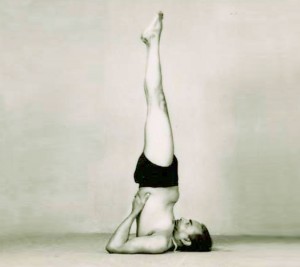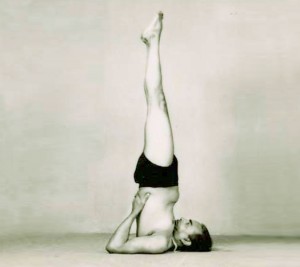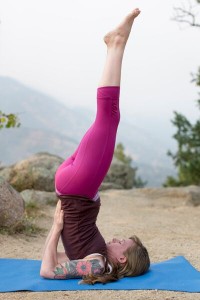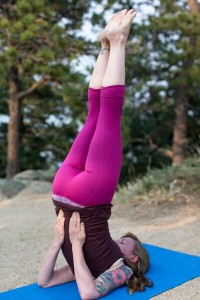 “It is no over-statement to say that if a person regularly practices Sarvangasana he will feel new vigour and strength, and will be happy and confident. New life will flow into him, his mind will be at peace and he will feel the joy of life.” BKS Iyengar
“It is no over-statement to say that if a person regularly practices Sarvangasana he will feel new vigour and strength, and will be happy and confident. New life will flow into him, his mind will be at peace and he will feel the joy of life.” BKS Iyengar
In light of all the “heaviness” this newfound cold and dark season brings, I have chosen this months Yoga posture as Sarvangasana (sometime called “shoulder stand”) to lighten up the energy and help the circulation flow freely throughout the body and mind. It is not surprising that many clients have contacted me lately about a recent dwelling of lethargy, lack of motivation, dull mind and overall feeling of BLAH! This posture is well known for the inverted affect of flushing out the system, awakening the mind and allowing fresh blood to circulate through the body. Although these are amazing effects you will experience when practicing this asana, Sarvangasana has quite a long list of heath benefits to offer otherwise.
Sarvangasana has been called the “Mother of asana” by the pioneer, master Yogi, BKS Iyengar.
“As a mother strives for harmony and happiness in the home, so this asana strives for harmony and happiness in the human system”
By this very clear statement from Iyengar, you can see that by practicing Sarvangasana regularly, one can establish balance in the body, making it beneficial for a wide range of ailments. Sarvangasana is even translates as “all limbs” as it is beneficial for the entire body (and mind!).
In the eyes of Ayurveda, Sarvangasana is known as a tri-doshic posture, as it helps to pacify all three doshas. It works on Vata by toning the pelvic region, alleviating constipation, removing stagnant energy, strengthening the bones, calming mind, relieving insomnia and healing nervous system disorders. It benefits Pitta by the flushing of vital organs such as the liver and spleen, relieving headaches (even chronic), balancing hormones, healing ulcers, soothing inflammation in the GI tract, removing irritation and balancing a “hot” temper. Finally, Sarvangasana works on Kapha dosha as it removes blockages in the body, awakens the mind, lifts lethargy, kindles motivation, boost the digestive fire, balances the thyroid and parathyroid glands, flushes the kidneys and relieves asthma, cold and congestion.
This posture is best performed daily, toward the end of the Yoga practice, prior to Shavasana (corpse pose). It can be seen as a cultivation of the practice to balance any residual imbalances that had not been fully attended to. It also will help to relieve any dullness or exhaustion that may have come up from overexertion from the previous asana work. This pose should be routinely practiced each day in order to experience the incredible benefits this asana has to offer (unless menstruation or other contraindication is present- see below). If this pose is not obtainable for you at this time, a modified version of Viparita Karani, often described as “legs-up-the-wall”, can be a nice restorative modification to end your practice instead.
Sarvangasana
- Doshic Qualities:Vata ↓,Pitta ↓, Kapha ↓
- Best Season for Practice: Beneficial in all seasons!
- Elemental Component: All 5 elements: Water, Earth, Fire, Air, Space
- Main Areas of Strengthening in the Body:Works on the entire body including the mind.; relieves fatigue while promoting strength and energy.
- Main Organs: All organs including the liver, gallbladder, spleen, kidneys, bladder, lungs, reproductive organs, endocrine organs and entire GI tract
Main Health Benefits of Sarvangasana
- Awakens the mind
- Increases energy and vitality; removes fatigue and lethargy
- Boosts confidence and motivation
- Removes obstruction and blockages from the body and mind
- Balances Vata, Pitta and Kapha
- Treats thyroid and parathyroid disorders
- Balances the endocrine organs; balances hormones
- Strengthens the bones (via the thyroid gland)
- Cleanses and strengthens vital organs including the kidneys, liver and spleen
- Promotes overall detoxification
- Increases the digestion
- Removes constipation
- Treats hemorrhoids
- Treats prolapsed organs
- Beneficial in urinary disorders
- Beneficial in respiratory disorders including asthma, bronchitis and congestion
- Beneficial in nervous system disorders including insomnia, anxiety, nervousness and epilepsy
- Reduces anger, irritation and hot temper
- Cardiac tonic
- Strengthens the blood; beneficial in anemia
- Removes depletion after illness
- Heals stomach ulcers and inflammation in the GI tract (colitis, etc)
- Beneficial in menstrual disorders (do not practice during menstruation however!)
Contraindications of Sarvangasana
- Menstruation
- Glaucoma
- Pregnancy
- Hypertension
- Enlarged liver or spleen
How to perform Sarvangasana
- Lie flat on the back in a reclined position. The body should be in one line, with the arms straight beside the torso and the palms facing downward. Take a few deep breaths here.
- On an exhale, begin to raise the legs into the air. This can be done with straight legs for the advanced practitioners, or by bending the knees into the chest to start for beginners. Take a deep breath here.
- From here, begin to press the palms into the floor as you raise the hips, butt and lower-mid back off of the ground. Once again, the legs can be straight up for this (for advanced) or can be bent into the chest if needed for beginners.
- Remove the palms from the ground and place them onto the lower back around the kidney area. The palms should be offering support here, with the fingers straight, pointed upward and the palms flat to the back.
- If the legs were bent, begin to straighten them upwards in a vertical line. If the legs were already straight, make sure they are in are directly above you, toes pointed toward the sky. There should be no bend in the knees. Try your best to be as vertical as possible to avoid the feet falling forward.
- Check in with the body. the only areas that should be touching the ground are the shoulders, back of the neck, triceps and the elbows. Adjust as needed otherwise.
- The chin should be tucked into the chest forming a “lock” known as Jalabandha. This lock massages the thyroid/parathyroid glands and also works on the lungs and respiratory system. The neck should be flat to the ground, as this presses on vital blood Marma points that increase the strength of the blood and promote circulation.
- When alignment is in order, check in with the breath making sure it is soft, slow, steady and even in both exhale and inhale. For beginners, this pose can be held for one minute when first learning the posture. However, this time should be increased each week by one minute until you reach 5 minutes. Advanced practitioners should stay in this position for a minimum of five minutes and increase gradually to 15 minutes (Light on Yoga, BKS Iyengar; page 212). However, if the legs get shaky and weak, this is a sign to come down early and continue to build up to the recommended time.
- When coming out, place the palms back onto the floor and slowly begin to lower the spine onto the ground, one vertebrae at a time. Once the butt is on the ground, slowly begin to lower the feet to the ground, ideally with straight legs.
- If you are familiar with Matsyasana (fish pose), this can be performed as the counterpose.
- Lay reclined in a straight line. Move the feet apart slightly, place the palms up and relax any tension in the body for Shavasana (corpse pose) to end the practice. Close the eyes here and release any control on the breath. Stay here with a present mind for up to 5 minutes.





Please tell me refernece of this asana in whivh text
Hi Jay,
Thank you for your question! The information is derived from “Light On Yoga” by BKS Iyengar. You will find several pages that go over this asana in depth. Some of the additional information comes from my teacher Shandor Remete of Shadow Yoga, with whom I had studied under for many years.
Please let me know if you have any further questions!
Namaste,
Danielle